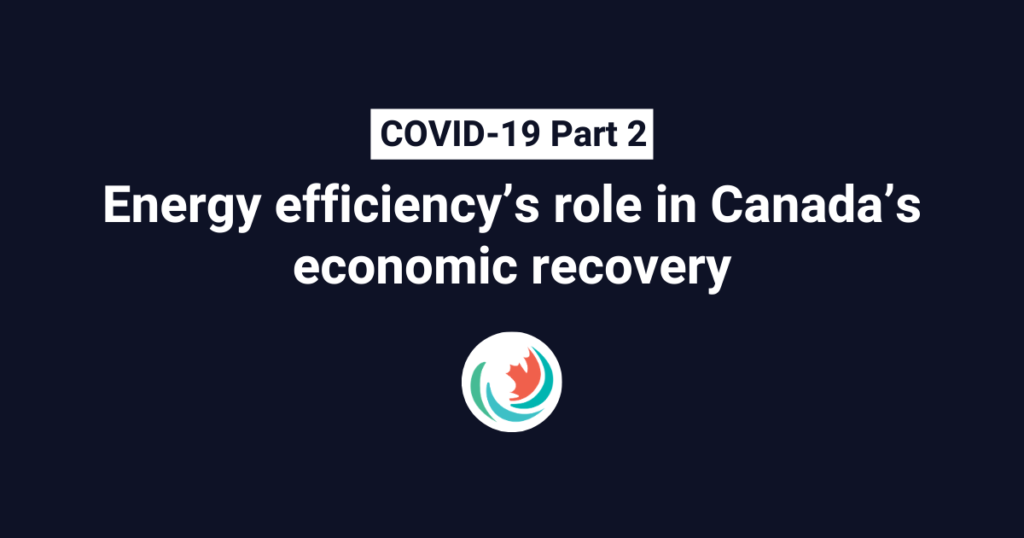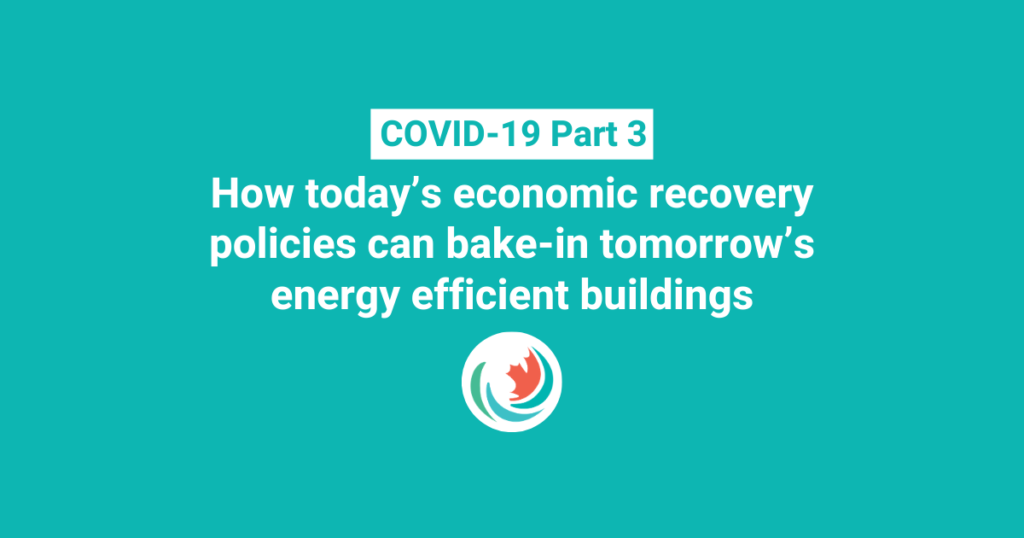An energy-efficient economic recovery in three steps
We can build a more energy efficient economy after the COVID-19 crisis ends. Work can start now — existing programs are ready to ramp up quickly — and energy savings present a long-term path for sustainable growth
Brendan Haley
May 13, 2020
Blogs | EE Recovery | News | Provincial Policy
- This blog presents a practical and ambitious three-stage plan to make energy efficiency a core part of Canada’s economic recovery strategy
- A three-stage framework applies both a short- and long-term lens to recovery from COVID-19
- We can build back better through training, expanding efficiency program portfolios, and “green bank” investment strategies
There is significant momentum for the recovery from COVID-19 to be defined by building a cleaner and more resilient economy. To learn about how energy efficiency fits into this equation, check out our blog series parts one, two, and three. This blog presents a practical and ambitious three-stage plan to make energy efficiency a core part of Canada’s economic recovery strategy.
In April, Efficiency Canada joined a coalition of industry and non-profit leaders, calling on the Prime Minister to direct government spending towards building a clean energy economy.
As part of this initiative, Clean Energy Canada defined a framework for a resilient recovery, considering specific policy actions in three stages: relief, stimulus, recovery.
The relief stage recognizes the need to provide immediate support for citizens and businesses while physical distancing measures help us reduce the virus’ transmission and alleviate pressure on our health care system.
The stimulus stage considers activities that can deliver results in 6-12 months to get people back to work. The quickest way to do this is to use existing administrative capabilities and policy programs.
The recovery stage recognizes the critical need to re-build a more economically and environmentally sustainable economy in the long-term.
This framework helps us apply both a short- and long-term lens to recovery activities, and consider the interactions between what activities can take place during physical distancing versus economic restart.
Relief: prepare, plan, train.
The energy efficiency sector will lose capabilities if there is a prolonged period of unemployment. Yet, there is an imperative to maintain and expand this workforce to meet climate change and economic recovery goals. A way to maintain and grow capabilities is to help out of work and underemployed people learn new skills.
Online training can take place while physical distancing, supplemented by on-site learning when it is safe. The federal government can provide support by subsidizing course fees for individuals and supporting organizations who are working to bring existing course offerings online.
Workers in the skilled trades are ageing, requiring an influx of new workers to avoid the threat of a major labour shortage. The new trades workforce is likely to look very different. Specific emphasis should be placed on engaging women in the trades, to provide higher paying and more secure employment for those who have lost their jobs in retail and service industries.
According to the Canada Green Building Council, we need $500 million for workforce development and training to meet low-carbon green building objectives. Funds can flow to existing training organizations, professional bodies, and trade unions, through relationships with Natural Resources Canada and Employment and Social Development Canada.
Increasing the supply of training services must be combined with programs which signal that there will be increasing demand for energy efficiency skills. Thus, training in the relief phase should be coupled with a clear commitment to a clean economy driven recovery, and planning to expand the scale and scope of efficiency activities during the “stimulus” phase.
Stimulus: expand “shovel worthy” program portfolios and upgrade public sector buildings.
There is an existing infrastructure of energy efficiency program delivery in every province and territory that can provide rapid, accountable, and effective support to Canadians. Our provincial scorecard showed that provincial program budgets totaled $1.1 billion in 2017, spanning residential, commercial, industrial, and low-income markets. Existing programs are reviewed by third-party experts, regulators, and stakeholders, and have systems for performance tracking and program evaluation in place.
As explained in this blog, Canadian provinces have room to catch up to leading American states in energy savings performance. Our macroeconomic study reveals that ramping up program savings to these levels would create 35,000 jobs in the first year, increasing to 280,000 annual jobs in year 8, and providing a $43 billion average annual increase in GDP. Achieving these results requires an immediate investment of $2.2 billion, ramping up to a $11.9 billion annual average investment levels. Expanding the scale and scope of existing portfolios can be achieved by using federal vehicles such as the Low-Carbon Economy Fund, the Green Municipal Fund, and the Climate Action Incentive Fund.
Within a portfolio approach that enables flexibility and adaptation, the federal government can place emphasis on performance criteria that prioritizes economic stimulus and greenhouse gas reductions. Including:
- Deeper energy retrofits to create more jobs
- Reducing energy poverty to help those most in need and increase local spending
- Advancing building codes to lock-in savings
- Promoting zero-carbon heating solutions to reduce emissions
The federal government can also launch immediate activities by upgrading federal buildings, and buildings in the larger public sector. Programs such as, Greening Government Services that use energy performance contracts and provide clear measurement and accountability, should be ramped up. A recent report indicated that 30% of federal-owned buildings in the National Capital Region are in “critical” or “poor” condition, which is likely indicative of the need for upgrades in other public buildings throughout the country. Topping up funding to achieve deeper savings in affordable housing through the National Housing Strategy is another important area.
Recovery: achieve energy saving missions through “green bank” public investment.
A durable recovery will only be achieved if we restore investor confidence and improve business expectations by providing a clear direction for future growth opportunities. An investment agenda will avoid boom-bust funding cycles and crowd-in the private sector. For this occur, government needs to lead by building economies of scale, demonstrating the economic opportunity, and taking on initial risks.
Other jurisdictions have created “green banks” or “climate banks” that spur new markets for building retrofits. These banks create supporting market structures, such as common underwriting standards and systems to aggregate multiple projects into large-scale portfolios, while also making initial investments. The Canada Infrastructure Bank could play this role, but it needs a clear change in mandate to meet financing needs and develop market institutions for distributed energy solutions, such as building retrofits and solar energy.
A federal “green bank” or building retrofit financing platform mandate should focus on meeting the grand challenges that will provide a clear direction for investment and innovation in the coming decades, including:
- Decarbonizing the building sector by 2050, if not earlier
- Making every new building net-zero energy ready by 2030
- Making Canada’s industrial energy productivity exceed the US by 2040
The Expert Panel on Sustainable Finance identified a retrofit opportunity of $250-$300 billion. Assuming standard leverage rates and capital recycling, an initial capitalization of at least $11 billion could spark this market. A sizable investment is needed to demonstrate that improving our building stock will be a major area for new investment in the post-COVID economy.
Build back better by creating an energy efficient economy
It is important to note that each of these suggested policy priorities builds upon the other.
A trained workforce will prepare for effective stimulus and must continue when investment scales up during economic recovery.
The immediate ramp-up of program portfolios will reinforce and expand supply chains capable of implementing investment projects for a “green bank.”
Investments through a “green bank” will focus on delivering long-term carbon reductions, in addition to making energy savings bankable for private investors, while program administrators continue to provide incentives to deliver utility system and provincial policy benefits.
These three steps indicate that energy efficiency activities must be supported right now, that efficiency programs are available and ready to provide a rapid boost to jobs and aggregate demand, and that building a more energy efficiency economy can define a long-term trajectory for investment and innovation required for a durable and meaningful recovery.
If you want to see an energy efficiency economy in the post-COVID world, now is the time to tell your elected representative. We’ve created an easy tool for you to send a letter to your representative in just a few clicks. If we raise our voice together, we have the opportunity to come out of this experience stronger.




